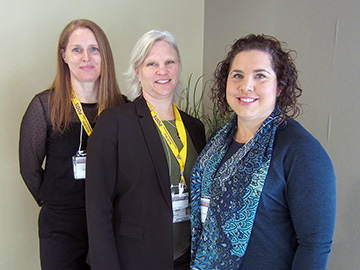News
St. Joseph's Hospital clients benefit from a new format of easy-to-understand care instructions

Kate Melchiorre, Denise Taylor,
and Mandy Byerly-Vita presented at CAHR's
2020 Research Showcase, getting the word
out about PODS
Date: 2020-02-18
A Patient-Oriented Discharge Summary (PODS) is clear, helpful care instruction document provided to St. Joseph's Hospital clients and families when they are discharged.
The PODS are here! No, not the campy sci-fi movie, but rather a Patient-Oriented Discharge Summary (PODS). The concept was introduced in a number of Ontario hospitals about two years ago, with St. Joseph’s Hospital adopting and adapting the summaries to meet client needs. When a client is discharged from the hospital, they receive a PODS, a four-page overview of their care needs, written in clear, easy-to-understand language. “Clients have always received care instructions when they’re discharged, but this is changing the process so the client can absorb it and ask questions before they leave,” says Denise Taylor, Manager of the Regional Rehabilitative Care Program at St. Joseph’s Care Group (SJCG). “It’s an effective tool for better preparing clients and families for discharge, which helps decrease readmissions to the emergency department and overnight hospital stays.” St. Joseph’s Hospital started implementing PODS on various floors in summer 2019, with a full roll-out to be complete over the next year. Let’s take a closer look at how a PODS works.
It’s comprehensive
On average, 5 professionals are involved in creating each PODS, including medical doctors, registered nurses, physiotherapists, social workers or occupational therapists, depending on the client’s condition and needs. The goal of each PODS is for the client to understand five key pieces of information through the acronym SMART: Signs and symptoms to watch out for, Medication instructions, Appointments, Recommendations for community services or equipment, and Telephone numbers and other contact information.
It’s clear
The language is simple. For example, the PODS may say “someone needs to help you walk” rather than “assist required for ambulatory care.” In the Medications section, there are checkboxes to show whether a prescription is at the pharmacy for pick-up or it has been given to the client or family member. Other sections include Appointments I Have To Go To, Changes And Symptoms To Watch Out For, and I Live Out of Town (with checkboxes to show if the health travel grant has been completed, and if the local nursing station or clinic has been notified of the person’s care and condition).
It empowers clients and families
One section that came as a result of feedback is “Goals That I Achieved and Intend to Continue.” “We added this to promote self-management of chronic diseases,” notes Kate Melchiorre, an occupational therapist in Geriatric Assessment and Rehabilitative Care at SJCG. After a health care provider has gone over the PODS with the client or family member, and the client is clear on what it says, the client signs and dates the document. “The whole point is that the client understands the next steps of their care,” she says.
Clients receive their PODS a day or two before discharge to give them time to thoroughly read and understand it and ask questions. That’s a big change from past practices, says Taylor, where a client could get their discharge instructions just before they left, when their mind may be focused on other things like collecting their belongings and making their way to the parking lot.
It’s customized
SJCG worked closely with staff as well as a Client & Family Partners working group to make sure the forms made sense and were useful for clients and their families. The final PODS has four pages (as opposed to two at some other organizations) to reflect the complex care needs that many clients have. There is also an addendum page, and clearly worded handouts about the client’s specific condition and needs (for example, symptoms of Chronic Pulmonary Obstructive Disease colour-coded by severity).
Does PODS work?
Both provincially and at St. Joseph’s Hospital, PODS are doing their job. Clients and family members report a better understanding of medications and feeling more involved in their care. Locally, 3.8% of clients had to go to the emergency room after they were discharged, compared to 11.6% pre-PODS—a drop of two-thirds, says Mandy Byerley-Vita, a social worker with SJCG. Similarly, overnight stays in the hospital dropped from 9.1% to 3.8%. Possible next steps include adapting PODS for outpatient clients, implementing PODS in regional hospitals and providing a summary for the client’s next care provider.
Peter Barr, an orthopedic client at St. Joseph’s, received his PODS when he was discharged in early February. “Each page was explained by my nurse and everything was made clear,” he says. “It helps to have all the information in a folder, all in one place. It explains what I need to know.”
